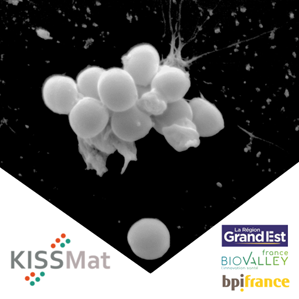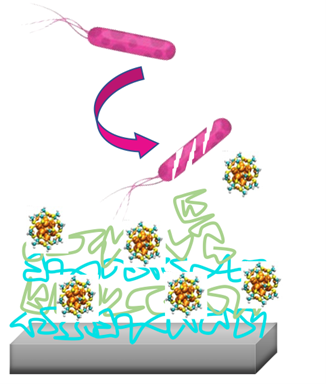The KISSMat project was officially launched a few months ago with the objective of identifying new antimicrobial solutions for the medical, cosmetic, and food sectors. KISSMat brings together several entities from the Grand Est region, that focus on designing a new generation of anti-infectious materials and coatings based on physiological metal nanoclusters and biopolymers.
Objectives of the KISSMat Project
The main objective of KISSMat is to create a new material capable of preventing and treating infections. This encompasses infection issues encountered with packaging or production in the food industry, cosmetics, and the medical sector (both human and animal health). Bacteria and fungi are major problems in these sectors, and antibiotics or antifungals are becoming less effective, primarily due to the development of resistance mechanisms by these pathogens.
Food safety has recently faced significant challenges with contamination of processed food products leading to fatalities. There is a need for antimicrobial work surfaces and effective methods for cleaning production tools that are compatible with the food industry.
In the medical sector, the emergence of antibiotic-resistant bacteria promotes the formation of biofilms on implants and, more generally, on all medical devices. In 2022, 1 in 20 patients hospitalized in France contracted a nosocomial infection, representing 850,000 patients. The healing of chronic wounds, particularly among diabetics with 50% of ulcers infected, is also a major public health issue where infection prevention and treatment are critical.
The acronym KISSMat refers to materials based on the universal concept « Keep It Simple Stupid, » as the project emphasizes simple approaches using 100% natural products that are assembled without chemical processes to form antimicrobial materials.

KISSMat’s Technology
The project is based on the development of two technologies that will then be combined:

The project’s partners
The project brings together three leading entities in innovation within the Grand Est, which are SPARTHA Medical, The Laboratory of Reactions and Process Engineering (LRGP / UMR 7274 CNRS, The University of Lorraine), The Laboratory of “Biomaterials and Bioengineering” (UMR_S 1121 Inserm /EMR 7003 CNRS, The University of Strasbourg).
The project is led by Dr. Nihal Engin Vrana (CEO of SPARTHA Medical), Prof. Ariane Boudier (LRGP), and Dr. Philippe Lavalle (“Biomaterials and Bioengineering”).

The Financial partners
This research project is supported by the Grand Est region with the assistance of Biovalley France’s competitiveness cluster, SATT Conectus, SATT Sayens, and Bpifrance, as part of their support and commitment to promoting cutting-edge innovation in the region. Their investment and support will provide the partners with the necessary conditions to achieve the first proofs of concept, emphasizing the importance of fostering collaborative efforts to drive technological progress.
Targeted Results
The results generated by KISSMat could significantly improve the prevention of pathogen-related risks in the food, cosmetic, and medical industries, as well as the treatment of infectious sites such as chronic wounds. By implementing innovative solutions developed through this research, these sectors can achieve higher levels of safety and quality, benefiting consumers, patients, and stakeholders.
Additionally, the Grand Est region will benefit from an economic growth generated by the research and development of new technologies, as well as increased visibility associated with supporting this initiative. This, in turn, could attract more investments and talent to the region, fostering an environment conducive to innovation.
